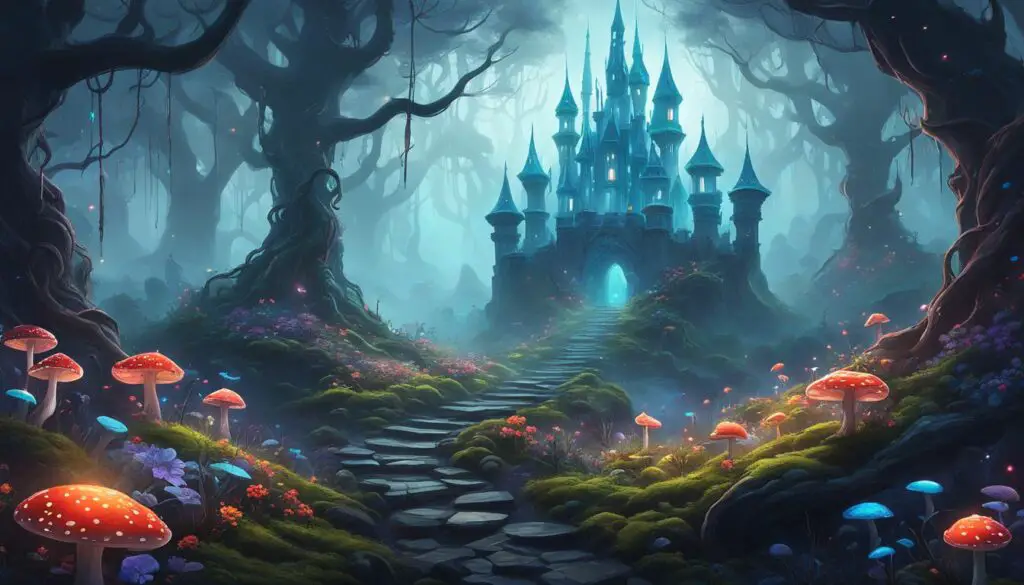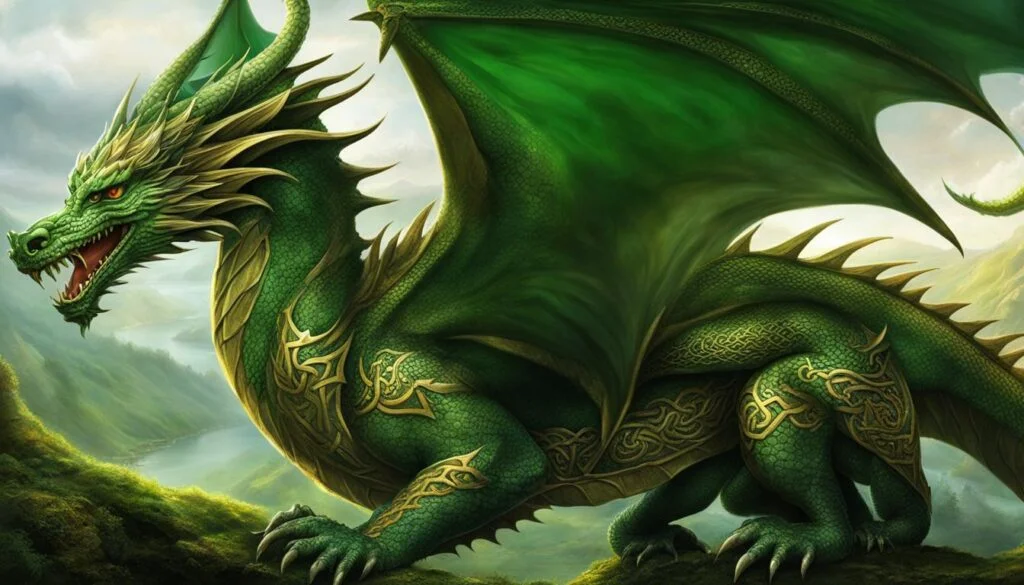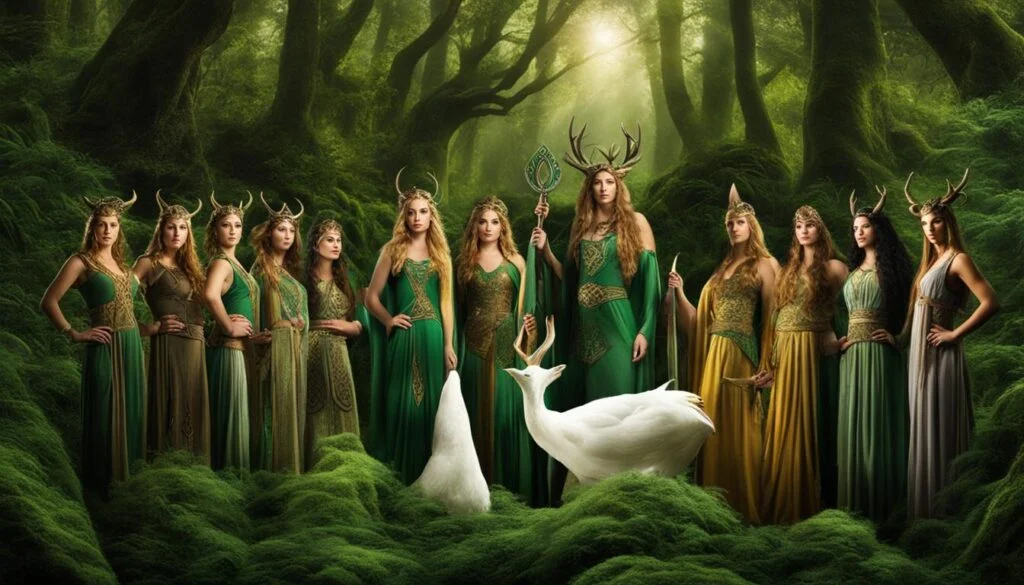Welcome to a journey into the enchanting realm of Celtic mythology and discover the fascinating concept of the Otherworld. Embracing legends, gods, and mythical creatures, the Otherworld is a mysterious realm that holds profound significance in Celtic cultures. In this article, we will delve into the depths of this magical realm, uncovering its various interpretations, characteristics, and how it is accessed.
Key Takeaways:
- The Otherworld in Celtic mythology is a mystical and magical realm associated with the gods, the afterlife, and mythical creatures.
- Within the Celtic regions, the Otherworld has different interpretations and can be seen as the home of deities, the realm of the dead, or a complex world of fairies and mythical beings.
- Gaining entry to the Otherworld requires special circumstances and can be achieved through ancient burial mounds, water crossings, or specific locations like lakes, bogs, caves, and hills.
- The Otherworld varies across different Celtic regions, adding diversity to the overall concept, with Irish mythology referring to it as Tír na nÓg, and Welsh mythology associating it with Annwn and Avalon.
- The Otherworld is depicted as a realm of eternal youth, beauty, and abundance, where time moves differently, and its inhabitants do not age or suffer ailments.
The Concept of the Otherworld in Celtic Mythology
In Celtic mythology, the Otherworld holds a significant place in the beliefs and legends of the ancient Celts. This realm is often depicted as the dwelling place of the gods and a realm where the souls of the departed journey after death. However, the Otherworld is not limited to the divine and the afterlife. It is also believed to be inhabited by a variety of mythical creatures, making it a captivating and enchanting realm.
The Otherworld is home to an array of Celtic otherworld creatures, including fairies, Twylyth Teg, and Aos Sí. These mystical beings are an integral part of Celtic mythology and are often associated with enchantment, magic, and nature. Legends and folklore describe their interactions with humans, weaving tales of both benevolence and mischief.
The Otherworld is often portrayed as a realm of eternal youth, good health, and abundance. It is a magical paradise where the laws of nature are different from our own world. In this realm, time flows differently, and its inhabitants do not age or suffer from illnesses. Instead, they enjoy everlasting youth and bountiful prosperity.
Mythical Creatures of the Otherworld:
- Fairies: Known in Celtic mythology as the Sidhe, fairies are ethereal beings who are often associated with nature and can possess both mischievous and benevolent traits. They are believed to dwell in mounds, lakes, and ancient forests.
- Twylyth Teg: These Welsh mythical creatures are similar to fairies and are known for their beauty and magical abilities. They are associated with nature, music, and the underworld.
- Aos Sí: In Irish mythology, Aos Sí refers to a group of supernatural beings, including fairies, who live in the Otherworld. They are believed to have the power to influence human lives and interact with individuals in various ways.
The Otherworld and its inhabitants continue to fascinate people to this day, inspiring countless stories, artwork, and interpretations. Their magical presence in Celtic mythology adds depth and enchantment to the cultural heritage of the Celtic people.
Through the imagery of the Otherworld and its creatures, Celtic mythology offers a glimpse into a realm beyond our own, where magic, beauty, and the mysteries of life abound.
Entry to the Otherworld
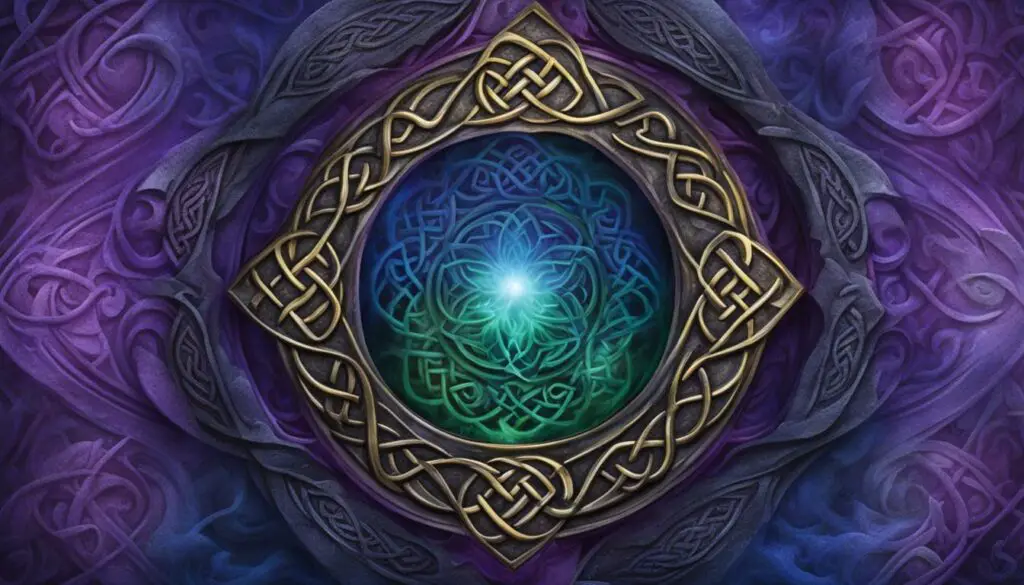
Gaining entry to the Otherworld in Celtic mythology is not easy and often requires special circumstances. Some worthy individuals are able to find their way through ancient burial mounds, water crossings, or specific locations like lakes, bogs, caves, and hills. It is also believed that the Otherworld exists in a parallel dimension or mirror-world alongside our own, and the veil between the two worlds thins during certain times of the year, making it easier to enter and exit.
Variations of the Otherworld in Celtic Regions
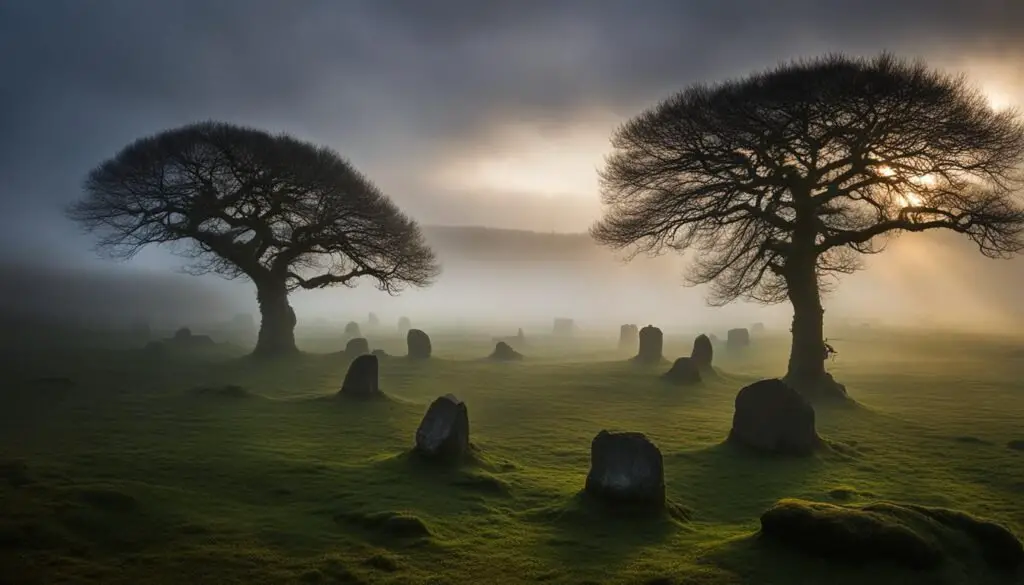
The concept of the Otherworld in Celtic mythology is not a fixed and uniform idea. Instead, it varies across different Celtic cultures, each contributing their own unique beliefs and interpretations of this mystical realm.
In some Celtic regions, the Otherworld is seen as a magical place teeming with fairies and enchanting beings. These fairies, often called the Aos Sí in Gaelic folklore, are believed to inhabit the Otherworld and possess extraordinary powers. This version of the Otherworld, sometimes referred to as the Celtic Fairy Realm, is filled with wonder and whimsy, where myth and reality intertwine.
On the other hand, in certain Celtic cultures, the Otherworld is conceived as a complex realm consisting of multiple mythical worlds. These worlds are thought to exist alongside our own, yet remain hidden from ordinary human perception. Each mythical world within the Otherworld is said to have its own distinct characteristics and inhabitants, ranging from divine beings to fantastical creatures.
These regional variations add rich diversity to the overall concept of the Otherworld in Celtic mythology. They reflect the unique cultural perspectives and folklore traditions of different Celtic cultures, making the Otherworld a truly multifaceted and captivating realm.
Otherworld Variations in Celtic Regions:
- The Celtic Fairy Realm: A magical place filled with fairies and enchanted beings
- Complex Mythical Worlds: Multiple worlds within the Otherworld, each with its own distinct characteristics
The Otherworld in Irish Mythology
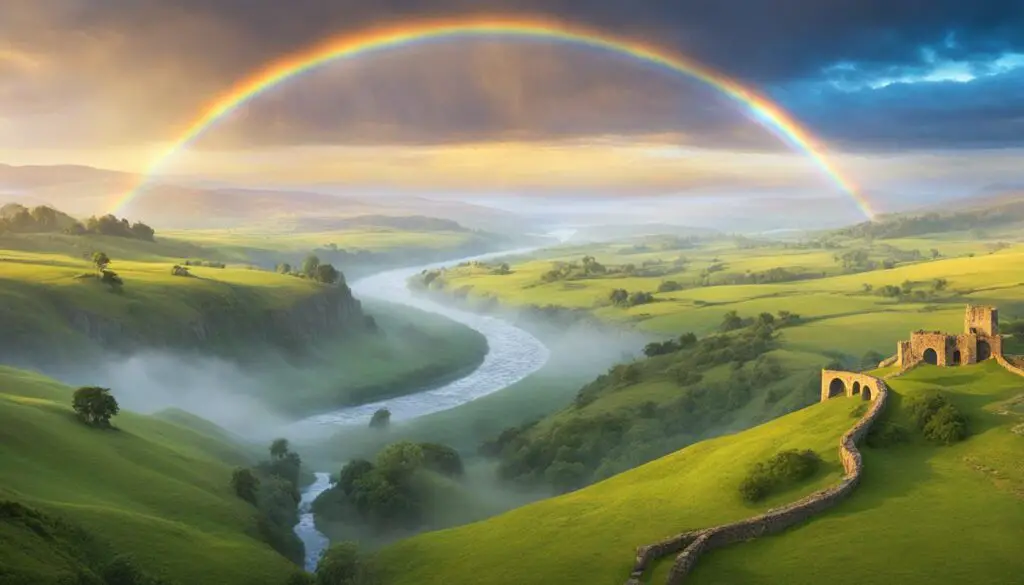
In Irish mythology, the Otherworld is referred to by different names such as Tír na nÓg (the Land of Youth), Tír Tarngire (the Land of Promise), and Tír-Innambéo (the Land of the Living). These realms are described as places of eternal beauty, abundant food, and everlasting youth. They are often depicted as islands in the Western Ocean or hidden beneath the waves.
In Irish lore, Tír na nÓg is a mystical land where time stands still and the inhabitants never age. It is said to be a place filled with stunning landscapes, vibrant flowers, and magical creatures. In Tír na nÓg, sorrow and pain are unknown, and the people live in eternal joy and peace.
Tír Tarngire, on the other hand, is believed to be a realm of promise and prosperity. It is said to be a land of abundance, with fertile fields and endless harvests. In Tír Tarngire, no one goes hungry, and the inhabitants thrive in a bountiful environment.
Tír-Innambéo, also known as the Land of the Living, is seen as a place where the souls of the deceased continue their existence in an eternal paradise. It is a realm of everlasting life and spiritual fulfillment.
These various names and descriptions of the Otherworld in Irish mythology highlight the allure and enchantment associated with this mystical realm. The stories and legends surrounding these realms continue to captivate imaginations and inspire awe.
The Otherworld in Welsh Mythology
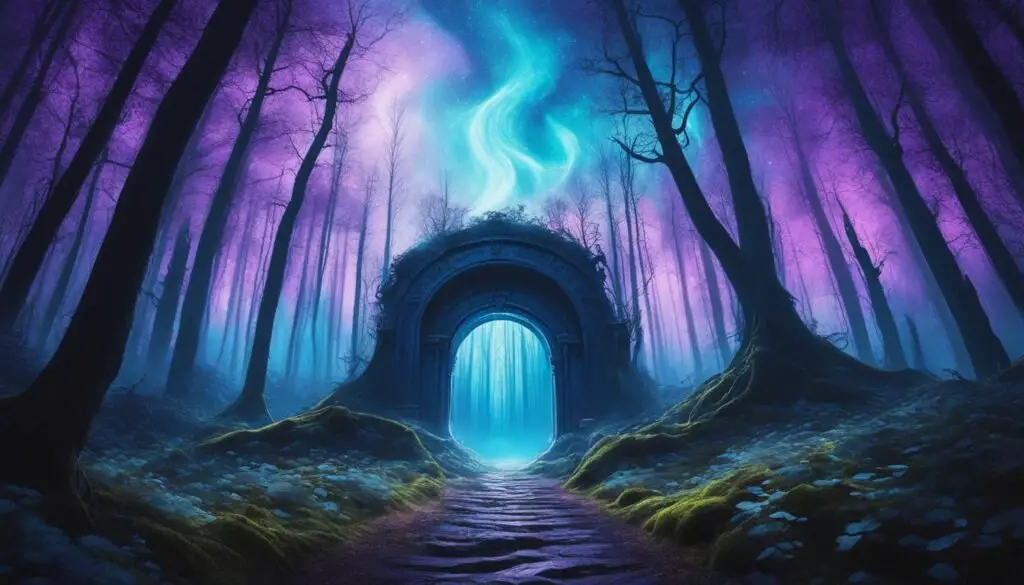
In Welsh mythology, the Otherworld is known as Annwn. Ruled by Arawn and later by Gwyn ap Nudd, Annwn is a realm described as a place of eternal youth, free from illness and death.
It is believed to offer endless supplies of food and drink, symbolizing abundance and prosperity.
Annwn holds a special connection to the legendary island of Avalon, often associated with it. Avalon is described as a paradisical Isle of Apples, a symbol of fertility and immortality.
Characteristics of the Otherworld
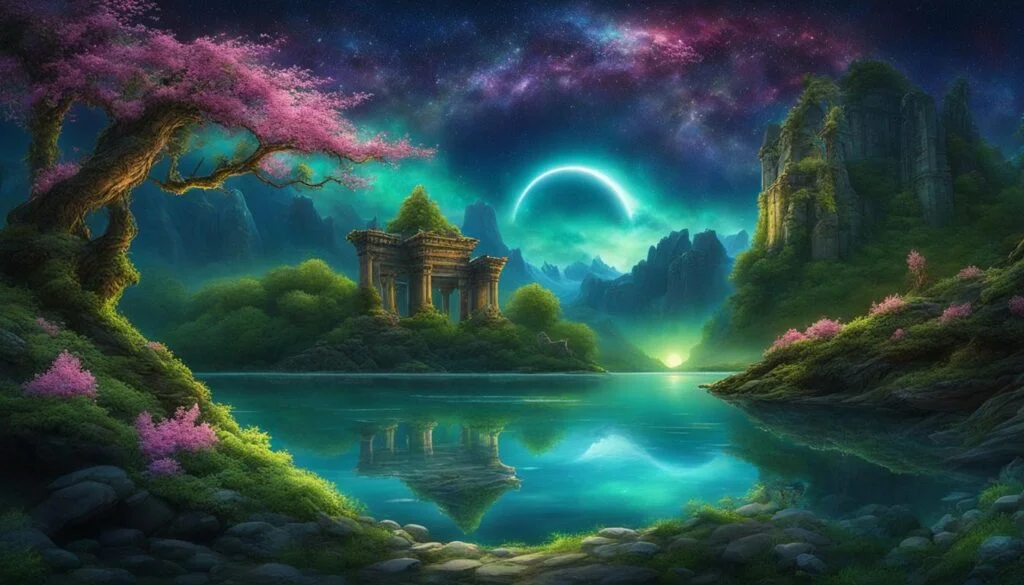
In Celtic mythology, the Otherworld is a realm that captivates the imagination with its enchanting characteristics. It is depicted as a place of beauty, joy, and abundance. The Otherworld is said to be adorned with vibrant flowers, magical trees, and fruits that are bountiful beyond belief. The colors are more dazzling, the scents more aromatic, and the tastes more exquisite than anything found in our ordinary world.
Time behaves differently in the Otherworld, flowing in a manner distinct from our own. Its inhabitants do not age, feel pain, or suffer from illness. Instead, they exist in a perpetual state of youth and vitality. Immersed in the harmonious energy of the Otherworld, they know nothing of the hardships and limitations that burden mortals. In this ethereal realm, peace and tranquility prevail, and the laws of nature possess a delicate balance.
The Otherworld embodies the idea of a sanctuary, an escape from the trials and tribulations of everyday life. It offers a glimpse into an alternate reality, where the vividness and vibrancy of existence are heightened. As the veil between our world and the Otherworld is lifted, one can only marvel at the wonders that lie beyond.
Accessing the Otherworld
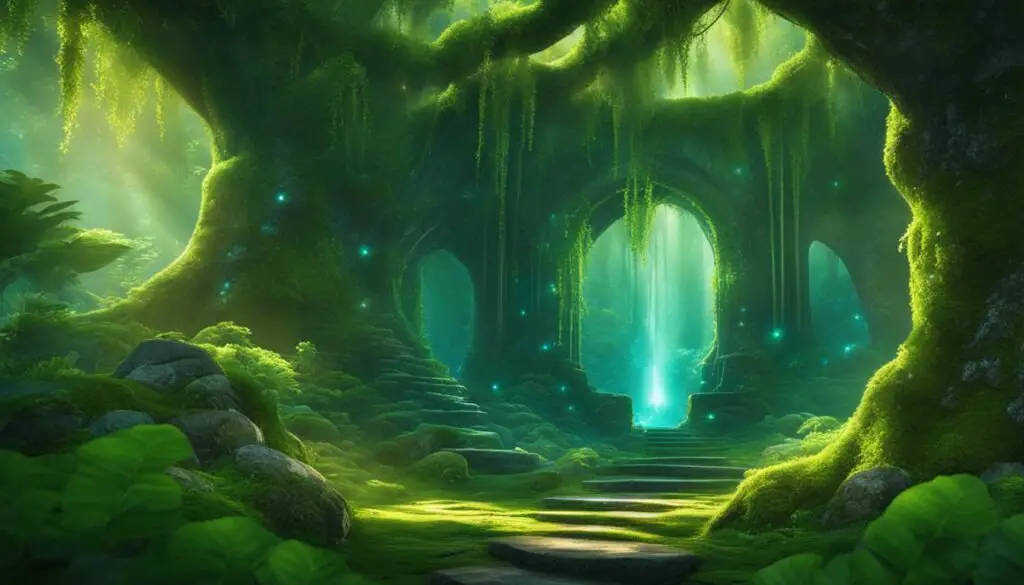
Gaining access to the Otherworld in Celtic mythology can be a task shrouded in mystery and intrigue. Various means exist for individuals to enter this magical realm, with each method holding its own unique significance.
Invitations and Summons: Gods and spirits of the Otherworld sometimes extend invitations or summon individuals to enter their realm. These privileged few are chosen for their worthiness or specific tasks assigned to them. Such invitations grant direct access to the wonders and secrets of the Otherworld, providing a rare opportunity to experience its enchantment firsthand.
Kidnappings and Abductions: In other instances, individuals may find themselves forcibly taken to the Otherworld by its inhabitants. These abductions are often depicted in Celtic folklore and can result in life-altering experiences, unexpected encounters, or transformative journeys. Those captured by the denizens of the Otherworld become unwilling participants in a realm filled with wonder and danger.
Passages and Portals: The most common means of accessing the Otherworld is through entrances located in specific locations. Caves, burial mounds, hills, and mountains serve as portals that connect our world with the realm of the Otherworld. These openings act as gateways, allowing brave adventurers to cross over into a realm of ancient magic and mystical beings. Journeying through these passages often leads to remarkable encounters, adventures, and new insights.
The Sacred Apple: In certain tales, possession of a sacred apple or branch acts as a key to unlock the doors to the Otherworld. This legendary fruit holds the power to grant entry to those who possess it, allowing them to traverse the boundary between our reality and the enchanted realm beyond.
Otherworldly Entry Points
- Caves: Dark, mystical caverns that conceal secrets and mysteries within their depths.
- Burial Mounds: Ancient sites of resting places for the departed, said to hold connections to the Otherworld.
- Hills: Mysterious elevations that are believed to house hidden entrances to the Otherworld.
- Mountains: Majestic peaks that act as gateways, leading daring adventurers into the realm beyond.
The Otherworld beckons with its allure of extraordinary experiences, magical encounters, and the promise of glimpsing the extraordinary. Those who are able to access this realm often emerge forever changed, their lives forever intertwined with the wonders of the Otherworld.
Otherworldly Encounters
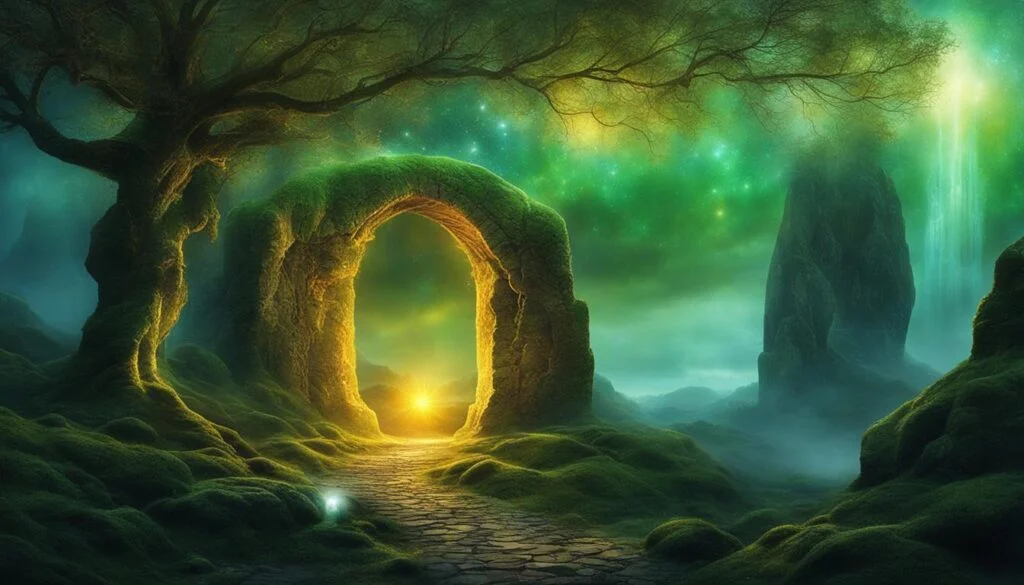
Celtic mythology is filled with captivating tales of humans encountering the Otherworld, leading to extraordinary experiences and profound transformations. These encounters often involve interactions with fairies, journeys to and from the Otherworld, and even musicians being stolen away to entertain its inhabitants.
Some individuals, enticed by fairies, are lured into becoming their lovers, experiencing a world far beyond the realm of mortals. Others are granted the rare opportunity to embark on journeys to the Otherworld and return, forever changed by their encounters with its enchanting wonders.
In certain instances, musicians are irresistibly summoned to the Otherworld, where their melodies captivate and entrance the mystical beings residing there. These encounters not only showcase the enchantment and magic of the Otherworld but also its irresistible allure on unsuspecting mortals.
Transformation and Enlightenment
These encounters with the Otherworld yield profound transformations and enlightenment for those involved. Individuals are granted glimpses into a realm where time bends and the laws of nature are altered. The experiences in the Otherworld often leave a lasting impact on mortal lives, forever changing their perspectives and understanding of the world.
Legacy of Otherworldly Encounters
The legacy of these encounters can be found in ancient Celtic literature and folklore, where they are passed down through generations as cautionary tales, fables, and sources of inspiration. These narratives continue to ignite our imaginations and bring the mystical and enchanting qualities of the Otherworld to life.
Tech Duinn – The Celtic Realm of the Dead
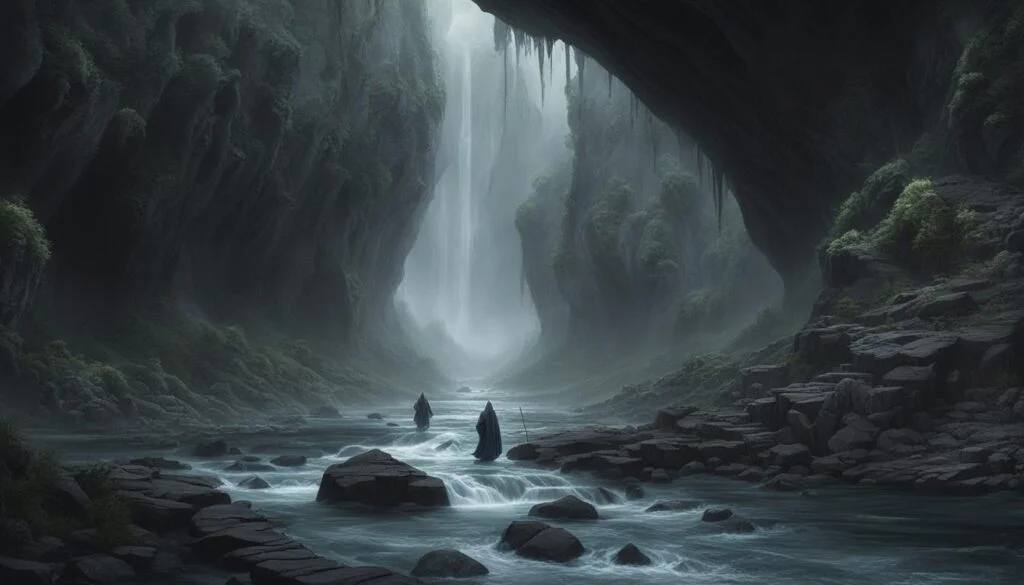
In Celtic lore, there is a separate realm called Tech Duinn that is associated with the afterlife. This realm is considered the domain of Donn, an ancient Celtic god of the dead. Tech Duinn is believed to be where the souls of the deceased go after death, and it is described as a distinct realm from the Otherworld.
- Tech Duinn is a mystical place where the departed souls find their final resting place.
- It is said to be a somber and solemn realm, shrouded in darkness and mystery.
- The souls in Tech Duinn are guided and cared for by Donn, who oversees their journey in the afterlife.
- While the Otherworld represents joy, abundance, and eternal youth, Tech Duinn is a realm of peaceful reflection and transition.
- It is believed that the souls in Tech Duinn eventually move on to their final destination, be it rebirth or union with the divine.
The concept of Tech Duinn reflects the Celtic belief in the cycle of life and death, and the importance of honoring and respecting the deceased. It adds depth and complexity to the overall mythology of the Celtic people, capturing the spiritual essence of their traditions.
The Mystical Nature of the Otherworld
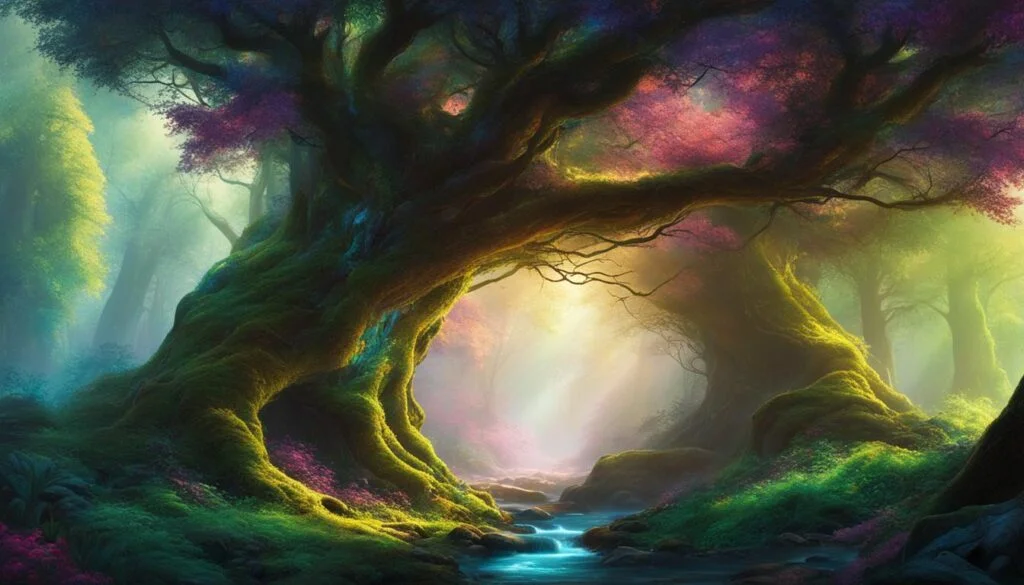
The Otherworld in Celtic mythology is a realm that enthralls with its mystical allure. It exists alongside our own reality, concealed from the perception of ordinary humans. This hidden realm is brimming with enchantment, serving as the abode of gods, fairies, and spirits. The Otherworld embodies the profound and spiritual beliefs of the Celtic people, captivating the imagination of those who delve into the captivating realm of Celtic mythology.
Within the Otherworld, the boundary between the mortal and the mystical dissolves, offering glimpses into a world where magic reigns. It is a place where extraordinary beings dwell, weaving their tales with threads of wonder and awe. This mystical aspect of the Otherworld beckons explorers to venture deeper, where secrets are unveiled and adventures await.
As ancient as the Celtic mythology itself, the mysteries of the Otherworld continue to spark curiosity and fascination. They inspire writers, artists, and dreamers alike, as they seek to capture the essence of this elusive realm. The Celtic mythology mysteries enshrouding the Otherworld invite us to explore the realms beyond our own and embrace the unseen forces that shape our world.
Conclusion
The Otherworld in Celtic mythology is a captivating and diverse realm that encompasses a multitude of interpretations and beliefs. It serves as a dwelling place for gods, fairies, and mythical creatures, while also being associated with the afterlife. Accessing the Otherworld is often challenging, requiring unique circumstances or invitations.
The Otherworld is often portrayed as a realm of eternal youth, beauty, and abundance. In this magical paradise, time moves differently, and its inhabitants enjoy perpetual youth, good health, and boundless resources. It holds a significant position within Celtic mythologies, inspiring modern interpretations and practices.
Exploring the Otherworld in Celtic mythology provides us with a glimpse into a mystical and enchanting dimension. Its lush landscapes, colorful flora, and harmonious ambiance evoke a sense of wonder and awe. The Otherworld’s allure continues to captivate the imagination of those who delve into Celtic mythologies, offering a deeper understanding of the ancient beliefs and traditions of the Celtic people.
FAQ
What is the Otherworld in Celtic mythology?
The Otherworld in Celtic mythology is a mysterious and magical realm associated with gods, the afterlife, and mythical creatures. It is a concept found in various cultures and has different interpretations within Celtic regions.
What creatures are associated with the Otherworld?
The Otherworld is believed to be the home of mythical creatures such as fairies, Twylyth Teg, and Aos Sí. These creatures are often depicted as magical beings that reside in the Otherworld.
Is the Otherworld the same as the afterlife in Celtic mythology?
Yes, the Otherworld is often seen as the realm where the dead go after life. It is considered a place of eternal youth, good health, and abundance.
How do people access the Otherworld in Celtic mythology?
Gaining entry to the Otherworld in Celtic mythology can be achieved through special circumstances. Some individuals find their way through ancient burial mounds, water crossings, or specific locations like lakes, bogs, caves, and hills.
Are there different interpretations of the Otherworld in Celtic mythology?
Yes, the concept of the Otherworld varies across different Celtic regions. Each culture has its own unique beliefs and interpretations. Some view it as the home of fairies and magical beings, while others see it as a complex realm with multiple mythical worlds.
What is the Otherworld like in Irish mythology?
In Irish mythology, the Otherworld is referred to by different names such as Tír na nÓg, Tír Tarngire, and Tír-Innambéo. These realms are described as places of eternal beauty, abundant food, and everlasting youth. They are often depicted as islands in the Western Ocean or hidden beneath the waves.
How is the Otherworld portrayed in Welsh mythology?
In Welsh mythology, the Otherworld is known as Annwn. It is ruled by Arawn and later by Gwyn ap Nudd. Annwn is described as a realm of eternal youth, free from illness and death, with endless supplies of food and drink. It is often associated with the legendary island of Avalon, a paradisical Isle of Apples.
What are the characteristics of the Otherworld in Celtic mythology?
The Otherworld is portrayed as a realm of beauty, joy, and abundance. It has colorful flowers, magical trees, and bountiful fruits. Time moves differently in the Otherworld, and its inhabitants do not age, feel pain, or get sick. It is often depicted as a place of peace and harmony, with different laws of nature compared to our own world.
How can someone access the Otherworld in Celtic mythology?
Gaining access to the Otherworld can be achieved through various means. Individuals can be invited or summoned by gods or spirits, kidnapped by Otherworld inhabitants, or voluntarily enter through openings such as caves, burial mounds, or specific locations like hills and mountains. Possession of a sacred apple or branch can also act as a key.
Are there stories of humans encountering the Otherworld in Celtic mythology?
Yes, Celtic mythology is full of stories of humans encountering the Otherworld. Some are lured or enticed by fairies to become their lovers, while others are taken on journeys to the Otherworld and back. These encounters often result in extraordinary experiences and profound transformations for the individuals involved.
What is Tech Duinn in Celtic mythology?
Tech Duinn is a separate realm associated with the afterlife in Celtic lore. It is considered the domain of Donn, an ancient Celtic god of the dead. Tech Duinn is believed to be where the souls of the deceased go after death, and it is described as a distinct realm from the Otherworld.
What is the mystical nature of the Otherworld in Celtic mythology?
The Otherworld is shrouded in mystery and wonder. It is a realm that exists alongside our own but hidden from ordinary human perception. It is a place of magic, where gods, fairies, and spirits reside. The Otherworld embodies the mystical and spiritual beliefs of the Celtic people and continues to captivate the imagination of those who delve into Celtic mythology.


